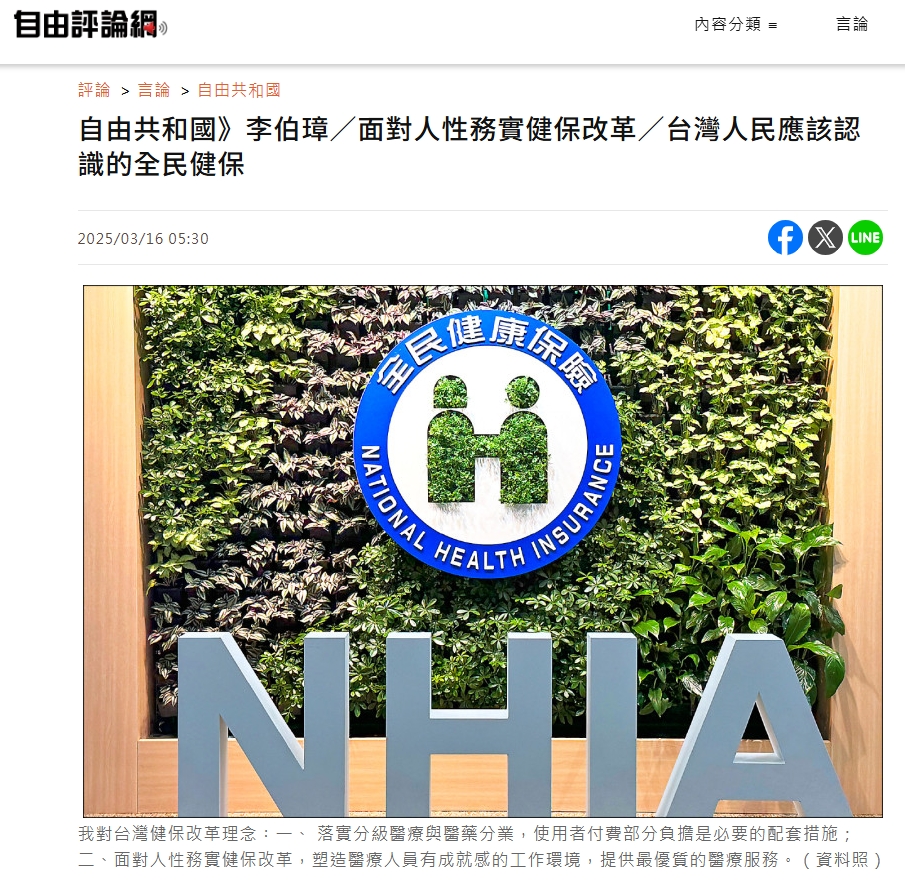【Column Article】The Free Republic: “Lee Po-Chang’s Column | Pragmatic Healthcare Reform in the Face of Human Nature – What the People of Taiwan Should Know About National Health Insurance”

Lee Po-Chang / Chair Professor, College of Public Health, Taipei Medical University
This book, which I co-authored with medical journalist Li Shu-Ren, was published last September. It provides a comprehensive explanation of the issues I encountered and the solutions I implemented during my six years and eight months at the National Health Insurance Administration (NHIA). The content covers the following topics:
- The Global Budget System, Point System, and Premium Rates of National Health Insurance (NHI).
- Key Pain Points of Taiwan’s NHI, Chronic Diseases, Non-Chronic Diseases, and Unhealthy Life Expectancy.
- The Healthcare Payment System, Physician Specialization Choices, Nursing Workforce, and NHI Coverage for Overseas Residents.
- The Establishment of the NHI Cloud-Based Medical Information Sharing System.
- Hierarchical Medical Referral System and Cost-Sharing Mechanisms for Patients.
- Pharmaceutical Benefits, Next-Generation Genetic Testing, and the Role of Private Insurance in Coordination with NHI.
- The Role of Fraud Investigation in NHI.
- My Lifelong Commitment to Medicine, including Advancing Kidney Transplantation and Promoting Organ Donation.
Epilogue: Persisting with a Calm Mindset in Doing the Right Things.
I understand that Taiwan has approximately 54,000 physicians, 200,000 nurses, and numerous public health and social science scholars, all of whom have extensive discussions on NHI. However, gaining a thorough understanding of the system’s practical operations requires time and study. Through professional charts and easy-to-understand explanations, this book aims to help medical professionals, public health scholars, hospital administrators, and the general public better understand Taiwan’s NHI and grasp the direction of future health insurance reforms.
I was born in Huwei Township, Yunlin County, and I still vividly remember my childhood experiences with healthcare. When I was in kindergarten, I had a high fever in the middle of the night, and my parents carried me to Dr. Lee’s internal medicine clinic for treatment. In elementary school, while washing dishes for my mother, I accidentally cut my wrist and had to be taken to Dr. Yang’s surgical clinic for stitches. These experiences with local doctors left a deep impression on me.
In 2015, Tainan faced its first large-scale dengue fever outbreak, with the majority of patients flooding into Cheng Kung University Hospital’s emergency department. At that time, Deputy Minister of Health and Welfare Lin Tzou-Yien instructed me to immediately designate two inpatient wards at Tainan Hospital to accommodate dengue fever patients. We first posted a notice advising non-severe cases to avoid seeking treatment at Tainan Hospital and then further instructed that non-dengue fever patients should not go there. This significantly alleviated the burden on Cheng Kung University Hospital. Patients with mild fever and discomfort received conservative treatment at Tainan Hospital, while those experiencing respiratory distress or requiring ICU and ECMO support were transferred to Cheng Kung University Hospital. This was a highly successful example of medical triage.
In 2018, to implement hierarchical medical care, NHIA actively promoted vertically integrated strategic alliances, which included:
- Taipei Region: 16 strategic alliances
- Northern Region: 13 hierarchical medical care projects
- Central Region: 18 strategic alliances
- Southern Region: 17 strategic alliances
- Kaohsiung-Pingtung Region: 14 strategic alliances
- Eastern Region: 3 strategic alliances
A total of 24 medical centers and 82 regional hospitals served as leading institutions, integrating 302 district hospitals and 6,600 primary care clinics into the system.
When people fall ill, they naturally want to receive treatment from the best doctors. National Taiwan University Hospital (NTUH), as the leading medical institution, often has patients lining up early in the morning to secure an appointment. To address this, NTUH launched the “Star-Moon Project”, collaborating with primary care clinics to enhance two-way referral mechanisms. Under this system, if a primary care clinic determines that a patient needs further evaluation at a medical center, they no longer need to queue at dawn. Instead, they can go to NTUH’s referral desk with a referral slip and secure one of the hospital’s reserved outpatient slots. After appropriate examination and treatment, follow-up care is provided at the original clinic, ensuring continuity of care. Many of the strategic alliances now follow this two-way referral model to facilitate hierarchical medical care.
Primary care physicians undergo rigorous training in medical centers and regional hospitals, and their capabilities are not in question—they provide excellent patient care. NHIA’s IT team has also enhanced the cloud-based medical information-sharing system, allowing primary care physicians to access lab test results and imaging reports from medical centers. This data transparency is at the core of hierarchical medical care. Since Taiwan already has a solid infrastructure, the government must actively promote public trust in primary care physicians. When necessary, patients will be referred to medical centers, preventing delays in disease progression. For instance, Kaohsiung physician Wang Hung-Yu has shown exceptional dedication to his patients while maintaining strong collaboration with local hospitals—this is the ideal model of hierarchical medical care that we aspire to achieve.
I must emphasize that while National Health Insurance (NHI) and Universal Health Coverage (UHC) share the goal of ensuring access to appropriate healthcare, their financial structures and operational strategies are fundamentally different. Politicians focus on securing more social welfare benefits for their constituents, social scientists advocate for social justice, and representatives on the NHI Committee are concerned about employers’ premium contributions. Meanwhile, healthcare providers continue to face excessive workloads. When have we ever heard the public express a willingness to pay more for the medical care they receive? Only overseas Taiwanese returning home truly realize how undervalued healthcare services are in Taiwan.
Beyond reducing unnecessary medical procedures to alleviate the workload of healthcare providers, adjusting reimbursement rates is the most pragmatic management strategy.
- 2017: Adjusted 1,716 critical care items, totaling NT$6 billion.
- 2020: Rationalized hospital and primary care reimbursement, totaling NT$12.4 billion, including NT$2.273 billion for 400 complex and severe conditions.
- 2021: Enhanced basic medical service payments, totaling NT$8.226 billion.
- 2023: Planned a comprehensive revision of the medical reimbursement system, intended to be completed over nine months. Unfortunately, I was unable to complete this mission, leaving health insurance reforms unfinished.
Currently, all levels of the healthcare system are dissatisfied with the reimbursement structure. The government must engage in transparent discussions with medical professionals across all specialties and hospital tiers—reform cannot be dictated solely by official mandates. The nursing night shift pay controversy serves as a prime example. For years, reimbursement points for surgical and invasive procedures have been suppressed, leading to the emergence of “sweatshop hospitals.” With nurses leaving the workforce and hospital bed shortages, ensuring reasonable reimbursement for inpatient care will be a key focus in future health insurance reforms.
We all know that having more funding makes reforms easier, but we must also spend wisely. Taiwan’s distorted healthcare resource allocation must be addressed. Outpatient care accounts for 70.3% of NHI expenses, while inpatient care comprises only 29.7%. I deeply appreciate Premier Su Tseng-Chang’s decisive support for the cost-sharing mechanism, despite opposition from some sociologists. However, the lack of co-payments for diagnostic tests and the removal of registration fee caps have stalled NHI reforms, ultimately undermining hierarchical medical care in Taiwan.



